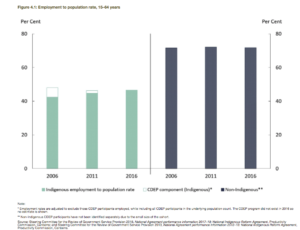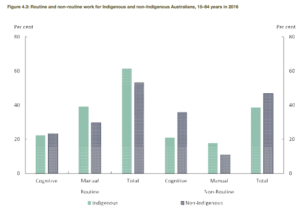The Closing the Gap 2019 report has been released and the state of employment for Aboriginal and Torres Strait Islanders does not look good. With the future of employment evolving, what can be done to help?
The Indigenous employment gap still has a long way to go, according to the recently released 2019 report.
Closing the Gap was first established in 2008 with the hopes to reduce disadvantage among Aboriginal and Torres Strait Islander in all aspects of life, including employment. The 2008 report aimed to halve the gap in employment outcomes between Indigenous and non-Indigenous Australians by 2018. It failed and is continuing to fail.
(As was true of previous reports, the latest data is from two years prior to the report being published, so 2016.)
The report says the closing the gap target has been affected by the discontinuation of the Community Development Employment Projects (CDEP) program.
“While the Indigenous employment rate declined by 1.3 percentage points to 46.6 per cent in 2016, the non-Indigenous rate remained stable at around 72 per cent. After adjusting for the impact of the CDEP, the Indigenous non-CDEP Indigenous employment rate increased from 42.4 per cent in 2006 to 46.6 per cent in 2016,” the report says.

Investments and incentives
All Australian states and territories are focusing on investing in closing the gap, but have acknowledged that the following areas need improvement:
- Delivering effective and culturally competent employment services through mainstream programs.
- Ensuring Indigenous-specific programs complement mainstream programs where necessary.
- Tailoring the Community Development Program (CDP) based on the needs of remote communities and job seekers.
- Ensuring Aboriginal and Torres Strait Islander Australians have access to quality employment opportunities, including in growth industries.
- Better understanding the employment opportunities of the future and link relevant educational offerings to ensure Indigenous Australians are job ready.
As of January 1 2018 the Federal government has also been providing businesses with Indigenous employees a wage subsidy of $10,000 (GST inclusive).
But why should there be a need for financial incentives to hire Indigenous Australians, and why is the gap not closing?
There are a range of reasons, but the report says having a society that values Aboriginal and Torres Strait Islander cultures and people provides a supportive environment for employment.
This is a complex issue, and there is a long history of cultural and social barriers that will take years of work to dismantle. But to respectfully simplify things (despite how problematic it feels to do so), businesses are reluctant to hire Indigenous Australians.
According to a report from Hays, only 30 per cent of employees say their organisation has a workforce that includes Aboriginal and Torres Strait Islanders, and a low 41 per cent have said they are committed to recruiting Indigenous Australians.
CEO of Arillia and Djiribul woman Shelley Reys says there is a reluctance in hiring Indigenous Australians due to a knowledge gap many people have.
Reys told SBS that “when you put the term ‘Aboriginal’, ‘Indigenous’, ‘First Nations’ or ‘reconciliation’ – any of those words, on top of something – good-natured [non-Indigenous] Australians start to get a bit nervous.
“They’re afraid of saying the wrong thing, doing the wrong thing, making a mistake or sounding racist, they just start to walk on eggshells.”
Chairperson of Babana Aboriginal Mark Spinks agrees with Reys and pointed out avenues that will help close the knowledge gap.
“I don’t believe that opinion will change in my lifetime,” Spinks says.
“I’ve placed several Indigenous men in positions with NRMA with the pledge that I would mentor them through their initial placement as well as continued support whenever I’m needed. I’m more then happy with the results and this process is very appealing for the employer and negates and nervousness they might have.”
Even if Spinks doesn’t think perceptions of Indigenous Australians will shift in his lifetime, if the gap is to close then they will have to.
Currently 56 per cent of Indigenous Australians are under 25 years old, compared to 33 per cent in the rest of the population, meaning young Indigenous Australians entering the workforce.
Worrying trend
Conventional barriers to Indigenous employment are not the only challenge if Australia is to close the gap. Unfortunately the data says that jobs that are Indigenous Australians are more likely to have are also among those likely to be automated.

This data is reflective of a number of factors, including the automation of many routine jobs and what jobs have been most attainable for Indigenous Australians.
“Over recent decades, employment growth has come from non-routine cognitive jobs such as managers and professionals, and more recently, from non-routine manual jobs such as community and personal service workers,” the report says.
With this growth in management and professional roles, there has been a much slower growth rate in manual roles such as technicians, trade workers, labourers and machine operators.
The report says industries with historically large workforces, such as retail and construction, will become susceptible to automation over the next few decades.
The way forward
As the future of employment changes there will need to be more support for job seekers to adapt.“My belief is that more mentoring services and programs need to be introduced as this assists with both job placements and job retention,” Spinks says.
Reys’ approach is a ‘good for business’ perspective. In a KPMG media release she says the following are key to culturally competent companies:
- Demystifying Indigenous matters by dispelling the myths and understanding the facts
- Understanding how it makes good business sense by showing that Indigenous employment enhances outcomes, social impact and brand reputation
- Decreasing unconscious bias while increasing capacity to engage, and
- Managing risk by encouraging better work practices.
It’s clear that there needs to be more done to halve this gap and the government is aware of it too.
“As we move into this next phase, Closing the Gap will be embraced as a whole of government agenda with all governments sharing accountability for progress and extending this shared accountability to include Aboriginal and Torres Strait Islander people,” says Prime Minister Scott Morrison in the report.
“We should not let our failure to meet targets overshadow the successful, thriving lives of many Aboriginal and Torres Strait Australians and the great work that many in our communities have been doing to improve outcomes for Aboriginal and Torres Strait Islander Australians.”
Going forward, the government has outlined their support for employment services to help close the gap, like:
-
- Mainstream employment programs, like jobactive and Youth Jobs PaTH.
- Funding of Indigenous-specific employment programs.
- Strategies to build and diversify the Indigenous allied health workforce which will benefit participants in the NDIS.
- The implementation of reforms to the Community Development Program (CDP) which aims to help remote job seekers transition from welfare to the workforce.
- Employing more Aboriginal and Torres Strait Islander people in Commonwealth-funded services.
The competitive labour landscape means that employee retention will become a critical challenge for employers now and in the future. Learn how you can attract and retain talent with this short course.


I am an indigenous woman. With work experiences as a Manager, I was unable to get a job. I am intelligent and hardworking so I decided to go to University and get a degree, thinking a lack of qualifications is the reason, which is not uncommon for indigenous people. I now have an MBA-HR specialisation. I took an internship in an HR Department contracted one year, got great references, still no job. I have found a lot of preconceived ideas and bias exist still, underpinned by nervous employers.
More education and understanding which removes fear and prejudice. I am not sure if we are teaching aboriginal culture in schools but we should be.
[…] Sixty-four per cent of female and 29 per cent of male workers in Australia and New Zealand say they have taken a career break, according to recruitment company Hays’s recent diversity and inclusion report. […]
[…] We are often approached by candidates who are looking to get back into the workforce after a career break, and want to get hired. They may have taken extended maternity leave, managed children or ageing parents or have been travelling the world (pre COVID), or taken time out to volunteer. 64% of female and 29% of male workers in Australia and New Zealand say they have taken a career break, according to a diversity and inclusion report. […]